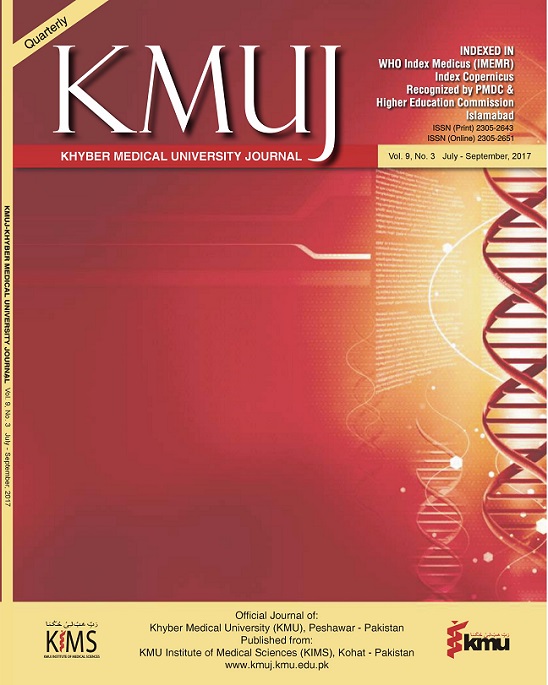FREQUENCY AND ASSOCIATION OF RISK FACTORS IN DEVELOPMENT OF GESTATIONAL DIABETES MELLITUS
Main Article Content
Abstract
METHODS: This study was conducted in the Khyber Teaching Hospital, Health Care Center, and Kalsoom Maternity Home Peshawar, Pakistan. The targeted population was the registered cases of pregnant women with GDM. Data was collected through properly designed questionnaire and antenatal cards of the GDM patients.
RESULTS: Out of 100 patients with GDM 64% patients had age >30 years and mean age was 31.25+5.25 years. BMI >25 kg/m2 was observed in 64% patients & mean BMI was 25.98+2.67 kg/m2. Seventy-three patients were multiparous and grand-multiparous, family history of diabetes mellitus (DM) was present in 71 patients while past history of GDM was present in 66% patients. Positive correlation was observed between advancing maternal age & GDM History (χ2=8.150, p=<.05, Phi and Cramer’s V test =0.626, p<0.001); advancing maternal age and parity (χ2=39.140, p=<.001, Phi and Cramer’s V test =0.285, p<0.05) in the development of GDM. Positive correlation was observed between BMI and parity (χ2=14.090, p=<.05, Phi & Cramer’s V test =0.375, p<0.05) as well as between parity and past GDM (χ2=38.302, p=<.0001; Phi and Cramer’s V test=0.619, p<0.01) in the development of GDM.
CONCLUSION: Advanced maternal age (>30 years), multiparty, BMI >25 kg/m2, history of GDM in the previous pregnancies and family history of DM were found to be the strong predictors of GDM.
KEY WORDS: Gestational Diabetes (MeSH), Advanced Maternal Age (Non-MesH), Parity (MeSH), Multiparity (Non-MeSH), Grand Multiparity (Non-MeSH), Body Mass Index (BMI) (MeSH)Article Details
Work published in KMUJ is licensed under a
Creative Commons Attribution 4.0 License
Authors are permitted and encouraged to post their work online (e.g., in institutional repositories or on their website) prior to and during the submission process, as it can lead to productive exchanges, as well as earlier and greater citation of published work.
(e.g., in institutional repositories or on their website) prior to and during the submission process, as it can lead to productive exchanges, as well as earlier and greater citation of published work.
References
American Diabetes Association. What is gestational diabetes? [Cited on December 17, 2016]. Available from URL: http://www.diabetes.org/diabetes-basics/gestational/what-is-gestational-diabet
Jiwani A, Marseille E, Lohse N, Damm P, Hod M, Kahn JG. Gestational diabetes mellitus: results from a survey of country prevalence and practices. J Matern Fetal Neonatal Med 2012 Jun;25(6):600-10. DOI: 10.3109/14767058.2011.587921. Epub 2011 Jul 15.
Ben-Haroush A, Yogev Y, Hod M. epidemiology of gestational diabetes mellitus and its association with Type 2 diabetes. Diabet Med 2004 Feb; 21(2): 103-13.
Randhawa MS, Moin S, Shoaib F. Diabetes mellitus during pregnancy: A study of fifty cases. Pak J Med Sci 2003;19(4):277-82.
Cnattinguis S, Lambe M. Trends in smoking and overweight during pregnancy: prevalence, risks of pregnancy complications and adverse pregnancy outcomes. Semin Perinatol 2002 Aug:26(4):286-95.
Cypryk K, Szymczak W, Czupryniak L, Sobczak M, Lewinski A. gestational diabetes mellitus- an analysis of risk factors. Endokrynol Pol 2008 Sep-Oct:59(5):393-7.
Harder T, Franke K, Kohlhoff R, Plagemann A. Maternal and paternal family history of diabetes in women with gestational diabetes or insulin dependent diabetes mellitus type 1. Gynaecol Obstet Invest 2005;51(3):160-4.
Roman H, Robillard PY, Verspyck E, Hulsey TC, Marpeau L, Barau G. Obstetric and neonatal outcomes in grand multiparity. Obstet Gynaecol 2004 Jun;103(6):1294-9.
Nassar AH, Fayyumy R, Saab W, Mehio G, Usta IM. Grandmultiparas in modern obstetrics. Am J Perinatol 2006 Aug;23(6):345-9.
Ostlund I, Hanson U, Bjorklund A, Hjertberg R, Eva N, Nordlander E, et al. Maternal and fetal outcomes if gestational impaired glucose tolerance is not treated. Diabetes Care 2003 Jul;26(7):2107-11.
Yang X, Hsu-Hage B, Zhang H, Zhang C, Zhang Y, Zhang C. Women with impaired glucose tolerance during pregnancy have significantly poor pregnancy outcomes. Diabetes Care 2002 Sep;25(9):1619-24.
Khan R, Ali K, Khan Z. Maternal and fetal outcome of gestational diabetes mellitus. Gomal J Med Sci 2013;11(1):88-91.
De Valk HW, Visser GHA. Insulin during pregnancy, labor and delivery. Best Pract Res Clin Obstet Gynaecol 2011 Feb;25(1):65-76. DOI: 10.1016/j.bpobgyn.2010.10.002. Epub 2010 Dec 24.
Khan A, Jaffery SN. Screening for gestational diabetes. Medical Channel 1997; 3: 8-12.
Seshiah V, Balaji V, Balaji MS, Paneerselvam A, Arthi T, Thamizharasi M, et al. Prevalence of gestational diabetes mellitus in South India (Tamil Nadu) - a community based study. J Assoc Physicians India 2008 May;56:329-33.
Torloni MR1, Betrán AP, Horta BL, Nakamura MU, Atallah AN, Moron AF, et al. Prepregnancy BMI and the risk of gestational diabetes: a systematic review of the literature with meta-analysis. Obes Rev 2009 Mar;10(2):194-203. DOI: 10.1111/j.1467-789X.2008.00541.x. Epub 2008 Nov 24.
Galtier F. Definition, epidemiology, risk factors. Diabetes Metab 2010 Dec;36(6 Pt 2):628-51. DOI: 10.1016/j.diabet.2010.11.014.
Ferrara A. Increasing prevalence of gestational diabetes mellitus: A public health perspective. Diabetes Care 2007 Jul 1;30(Suppl 2):S141-6.
Nohira T, Kim S, Nakai H, Okabe K, Nohira T, Yoneyama K. Recurrence of gestational diabetes mellitus: Rates and risk factors from initial GDM and one abnormal GTT value. Diabetes Res Clin Pract 2006 Jan;71(1):75-81. Epub 2005 Jul 6.
Khan R, Ali K, Khan Z. Socio-demographic risk factors of gestational diabetes mellitus. Pak J Med Sci 2013 May;29(3):843-6.
